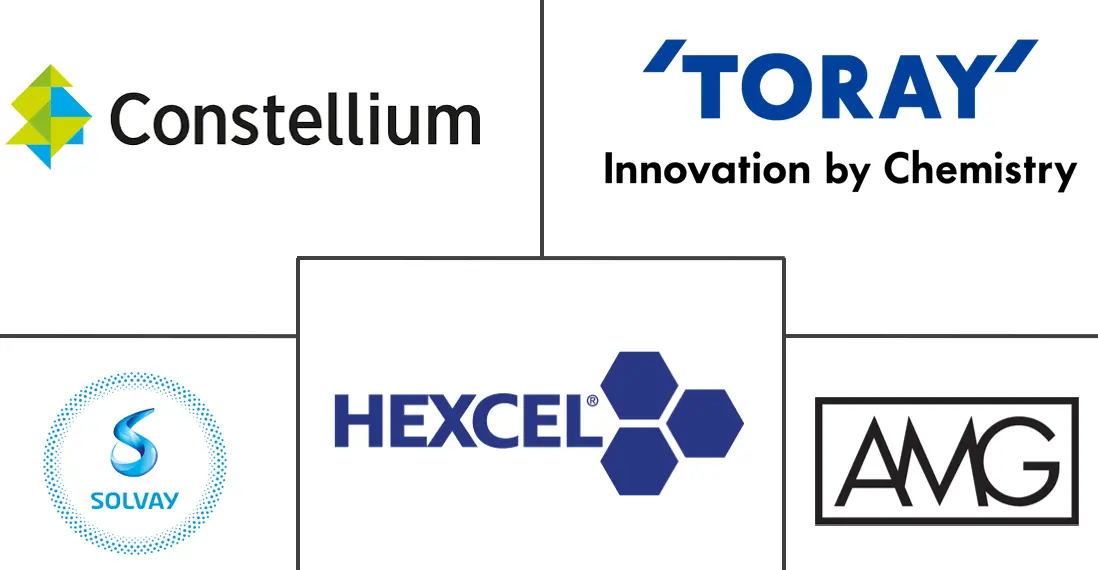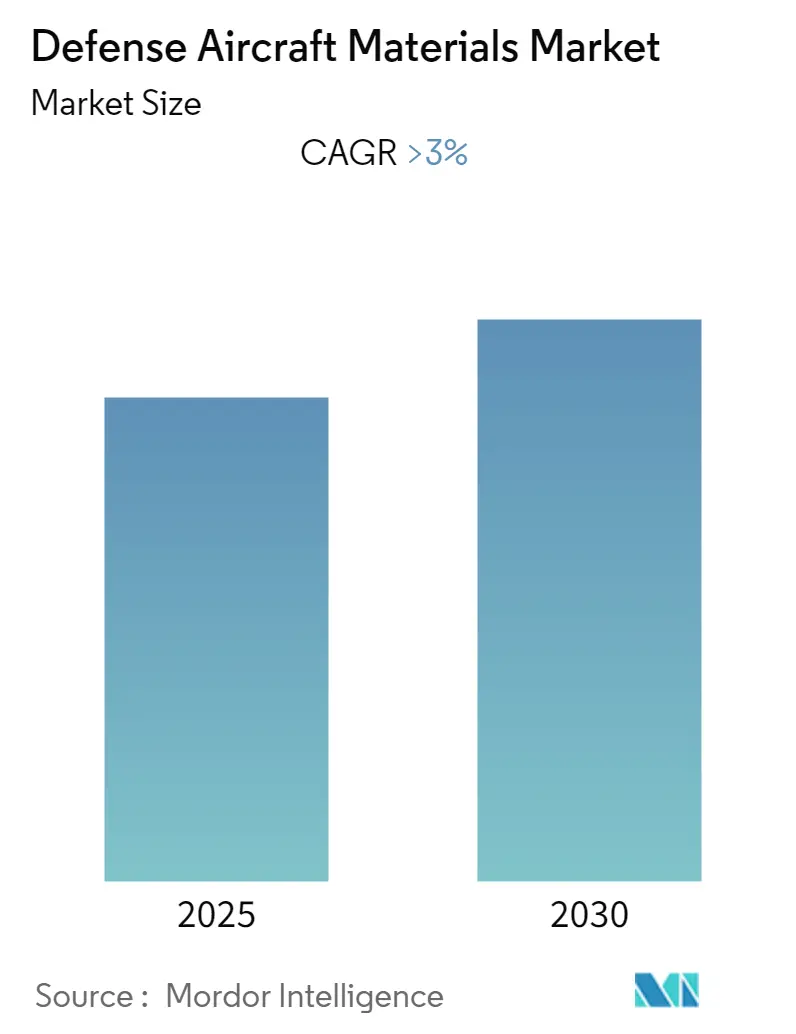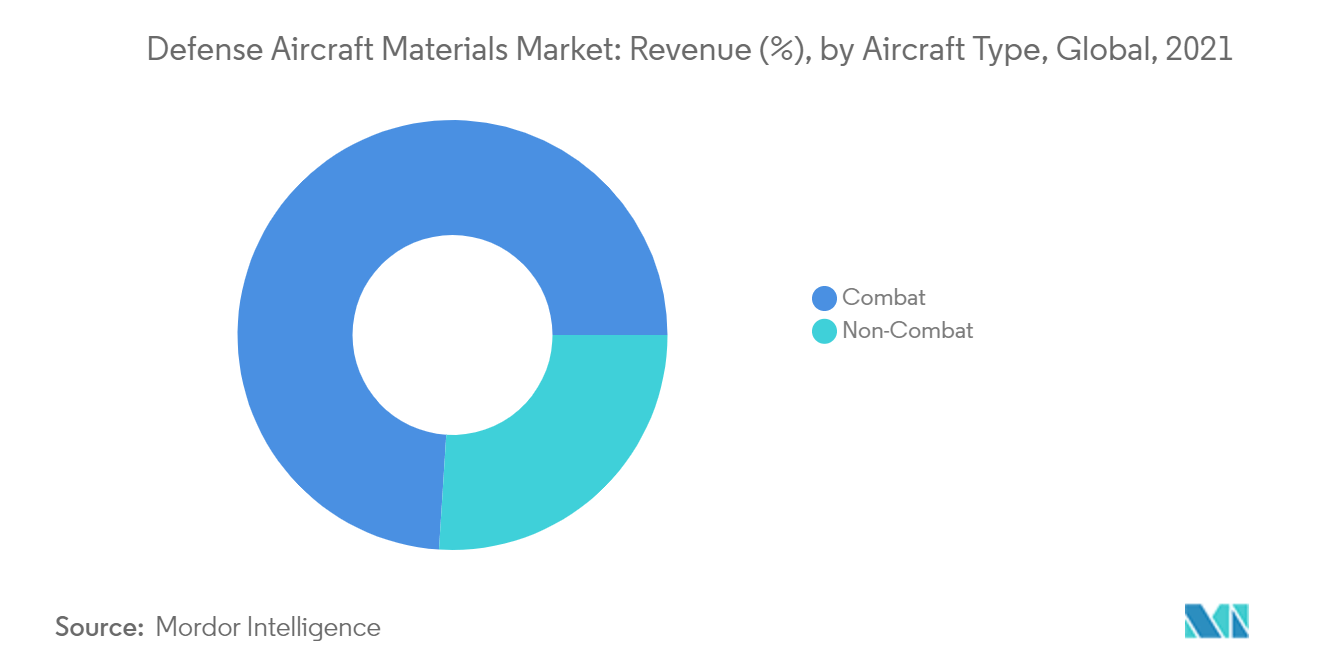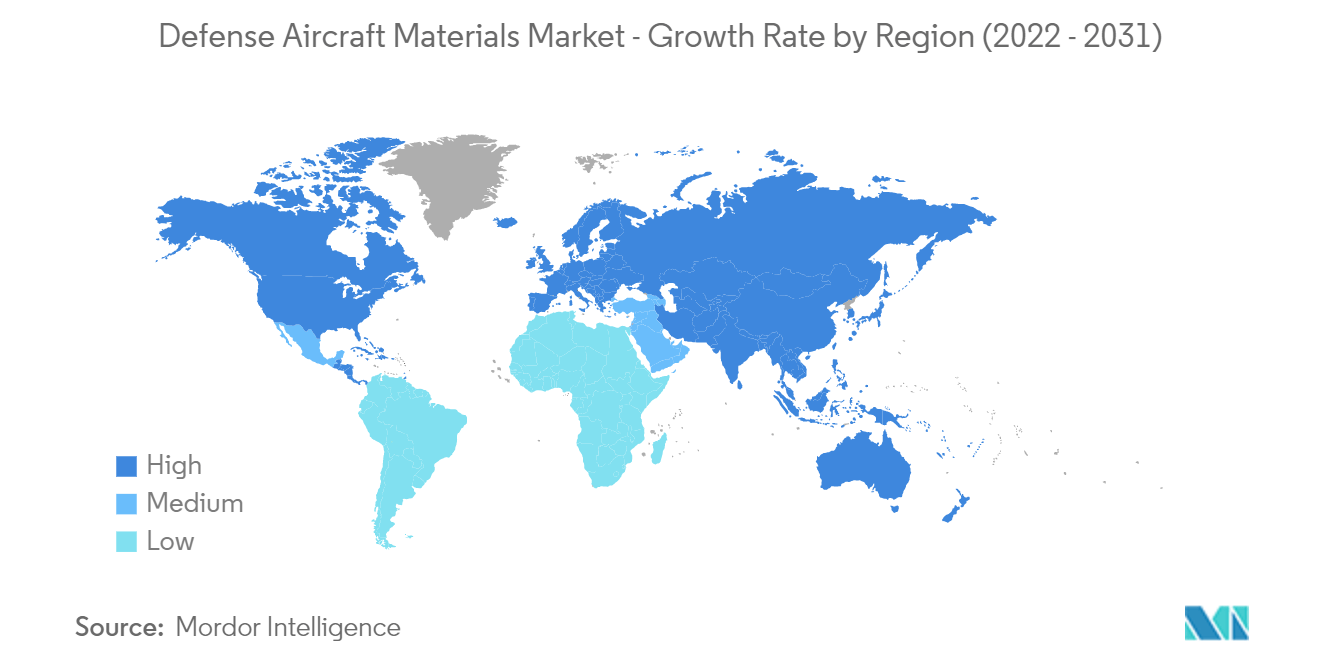Defense Aircraft Materials Market Analysis
The Defense Aircraft Materials Market is expected to register a CAGR of greater than 3% during the forecast period.
The COVID-19 pandemic had a slight impact on the Defense Aircraft Materials Market. For a minor part of 2020, the global lockdown and social distancing norms have led to severe supply chain constraints and a shortage of raw materials across the world. With the gradual relaxation of lockdown and the reduced impact of the pandemic, the supply chain of the materials was restored, and production rates started coming back to normal.
On the other hand, the defense spending and the budgets allocated towards aircraft procurement continued to increase in 2020 and 2021, despite the impact of the pandemic. The growing military conflicts between different countries and the rising demand for military aircraft among major countries are driving the demand for aircraft materials used in various aircraft across the world.
Emerging fabrication technologies and manufacturing processes are envisioned to improve the current properties of the military aircraft materials and foster the impetus for developing new alloys for manufacturing high-performing aircraft parts and airframe structures.
Defense Aircraft Materials Market Trends
Combat Aircraft Segment to Dominate the Market During the Forecast Period
Combat aircraft are vital for protection against aerial threats, as they can engage in aerial warfare and ground-support missions. Global military powerhouses, such as the United States, the United Kingdom, China, France, and Japan, are vying to achieve a profound reconceptualization of modern aerial warfare techniques by fostering the indigenous development of the fifth generation and the envisioned sixth-generation combat aircraft. The F-35 Joint Strike Fighter (JSF) from Lockheed Martin is one of the most advanced combat aircraft currently in service. In 2021, the company delivered 142 F-35 fighter jets to the United States and its allies, three more than previously planned. UAE, Japan, Qatar, the UK, Singapore, and Germany are some of the countries that have either placed orders or are planning to procure combat aircraft during the forecast period. With the growing demand for various materials that could be used in developing and building next-generation aircraft, major countries have been investing in testing new materials for aircraft implementation. With the increasing threat from China, Japan has invested heavily into developing a new fighter jet F-X. This aircraft was revealed in March 2022, expected to be developed with joint partnerships with International manufacturers like Lockheed Martin and BAE Systems. This aircraft is manufactured by Mitsubishi Heavy Industries and will use an extensive amount of composite materials that make it lightweight while being resistant to extreme working conditions. The aircraft will be the most powerful aircraft to date from Japan and is expected to first fly by 2035, significantly improving the potential for high growth in demand for composite materials during the forecast period.
North America to Continue its Dominance in the Market
North America region currently dominates the market and is anticipated to continue its dominance over the market majorly due to the robust military aircraft procurement plans of the United States. The country is currently the largest military spender in the world. According to the Stockholm International Peace Research Institute (SIPRI), the US spent USD 801 billion on its military in 2021, valued at approximately 3.5% of its GDP, which accounted for about 38% of the global military expenditure. Furthermore, the revised budget estimates for 2022 amounted to USD 782 billion, a 5.6% increase over the 2021 budget estimates. The budget earmarks about USD 15.7 billion for the Air Force's aircraft procurements. Furthermore, the FY 2023 budget request of the Air Force is approximately USD 169.5 billion dollars, of which USD 18.5 billion is sought for aircraft procurements. Composite material research has also been on the high, owing to the demand for lightweight and efficient materials. As a result, OEM partnerships with component providers have also been on the rise, to bring new lightweight and efficient components. For instance, in April 2021, Continuous Composites successfully completed the Air Force Research Laboratory's two-year Wing Structure Design for Manufacturing (WiSDM) contract through Lockheed Martin to manufacture a Low Cost Attritable Aircraft (LCAA) wing. This will greatly reduce the weight of the wing, improving speed and efficiency of the aircraft. On the other hand, Canada has been developin new materials for flight body. For instance, in April 2022, Raytheon Technologies' Collins Aerospace created a new business unit that will allow the company to build critical parts for next-generation military aircraft and hypersonic weapons. The unit will work towards developing new types of composite materials that could be used to make futuristic aircrafts.
Defense Aircraft Materials Industry Overview
AMG Advanced Metallurgical Group N.V., Solvay SA, Constellium SE, Hexcel Corporation, and Toray Industries Inc., are some of the major players offering aircraft materials to defense aircraft manufacturers across the world. The rapidly evolving aerospace industry calls for a solid supply chain, where transparency and traceability are of paramount importance, especially since the aircraft OEMs face mounting market pressures to increase production rates through continuous improvement and automation while keeping an eye on sustainability and energy/cost efficiency. Thus, a reliable, standardized production process and consistent data capture throughout the production cycle are crucial to ensure repeatability, while ensuring the quality of the finished materials. However, the regional market is consolidated, as strategic collaborations have become frequent. The stringent safety and regulatory policies in the defense sector are expected to restrict the entry of new players. Nevertheless, the growth in the focus on indigenous production of aircraft and localization of supply chains is expected to increase the number of players in the market.
Defense Aircraft Materials Market Leaders
-
AMG Advanced Metallurgical Group N.V.
-
Solvay SA
-
Constellium SE
-
Hexcel Corporation
-
Toray Industries, Inc.
- *Disclaimer: Major Players sorted in no particular order
Defense Aircraft Materials Market News
- In May 2022, the French company Daher announced an investment of EUR 7.5 million to build a tech center that researches new composite materials that could be suitable for various aviation applications including military aviation, to cater to the increased demand for lighter and stronger composite aircraft materials.
- In February 2021, Hindustan Aeronautics Limited (HAL) signed an agreement with MIDHANI, to develop and manufacture composite raw materials. These composite materials are planned to be used in platforms like Light Combat Aircraft (LCA), Advanced Light Helicopter (ALH), Light Combat Helicopter (LCH), and Light Utility Helicopter (LUH).
Defense Aircraft Materials Industry Segmentation
A modern military aircraft is composed of several metal alloys and composite structures joined to create the specific structural profile of the airframe and other constituent parts and components that fulfill the specified operational requirements of the aircraft. The market is segmented based on aircraft type into combat and non-combat. The market is also segmented by material type into aluminum alloys, steel, titanium alloys, and composites. The report also covers the market sizes and forecasts for the market in major countries across different regions. The market sizing and forecasts have been provided in value (USD million).
| Aircraft Type | Combat | ||
| Non-combat | |||
| Material Type | Aluminum Alloys | ||
| Steel | |||
| Titanium Alloys | |||
| Composites | |||
| Geography | North America | United States | |
| Canada | |||
| Europe | United Kingdom | ||
| Germany | |||
| France | |||
| Rest of Europe | |||
| Asia-Pacific | China | ||
| India | |||
| Japan | |||
| South Korea | |||
| Rest of Asia-Pacific | |||
| Latin America | Brazil | ||
| Rest of Latin America | |||
| Middle-East and Africa | Saudi Arabia | ||
| United Arab Emirates | |||
| Turkey | |||
| Rest of Middle-East and Africa | |||
Defense Aircraft Materials Market Research FAQs
What is the current Defense Aircraft Materials Market size?
The Defense Aircraft Materials Market is projected to register a CAGR of greater than 3% during the forecast period (2025-2030)
Who are the key players in Defense Aircraft Materials Market?
AMG Advanced Metallurgical Group N.V., Solvay SA, Constellium SE, Hexcel Corporation and Toray Industries, Inc. are the major companies operating in the Defense Aircraft Materials Market.
Which is the fastest growing region in Defense Aircraft Materials Market?
Asia Pacific is estimated to grow at the highest CAGR over the forecast period (2025-2030).
Which region has the biggest share in Defense Aircraft Materials Market?
In 2025, the North America accounts for the largest market share in Defense Aircraft Materials Market.
What years does this Defense Aircraft Materials Market cover?
The report covers the Defense Aircraft Materials Market historical market size for years: 2019, 2020, 2021, 2022, 2023 and 2024. The report also forecasts the Defense Aircraft Materials Market size for years: 2025, 2026, 2027, 2028, 2029 and 2030.
Our Best Selling Reports
Defense Aircraft Materials Industry Report
Statistics for the 2025 Defense Aircraft Materials market share, size and revenue growth rate, created by Mordor Intelligence™ Industry Reports. Defense Aircraft Materials analysis includes a market forecast outlook for 2025 to 2030 and historical overview. Get a sample of this industry analysis as a free report PDF download.







